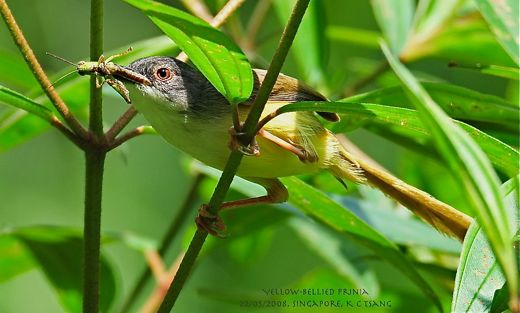“The Yellow-bellied Prinia (Prinia flaviventris), which is grouped among the African warbler family, is considered to be common, and resident breeding in Singapore. They can be found among lallang grass (Imperata cylindrical), and other bushy plants in open, often degraded land that had been previously bulldozed over and prepared for construction of Housing and Development Board apartments or other uses. Land that had been left alone for some while, long enough for fast growing plants to recolonise it.
“This bird, with a grasshopper between it’s bill, was about to take it to her chicks (above). But are they actually her chicks? One need to ask this as these birds are often being brood-parasitised by the Plaintive Cuckoo (Cacomantis merulinus).
“The calls of this delicate looking bird often starts with mewing, like that of a cat, then it goes into a very pleasant repetitive rhythm, very difficult to describe.”
According to Wells (2007), the “song is delivered from a prominent perch at the top of cover, is a hurried tidli-idli-ul, stressed on the first and last syllables and repeated at length, sometimes with intercalation of an extra idli. The alram call is a scolding (almost mewing) cheeair single or repeated once, and males (only?) produce a sharp, cracking or tearing wing-throb, prr’up, repeated rhythmically as they fly over their territory (this noise also recorded from a nest-builder).”
KC Tsang
Singapore
May 2008
Reference:
Wells, D.R. (2007). The birds of the Thai-Malay Peninsular. Vol. II, Passerines. Christopher Helm, London.










4 Responses
Please could you post the bird’s calls/songs
Sorry, we do not have its call.
Hi Hallma, the mewing of a hungry kitten should do the job, try it ….
but I cannot guarantee that it will work…
Hi K C
Thank you very much. I got the Prinias on camera and they do indeed make mewing sounds(I wasn’t sure it was the Prinias). I wasn’t sure of their calls because they visited my garden in a mixed bunch with sunbirds and tailor-birds. And in the cacophony, individual bird sounds were indistinguishable.